Heart and cholesterol urdu
5 likes4,435 views
A book let about care and caution for heart in urdu by Riaz Masud
1 of 32
Downloaded 84 times
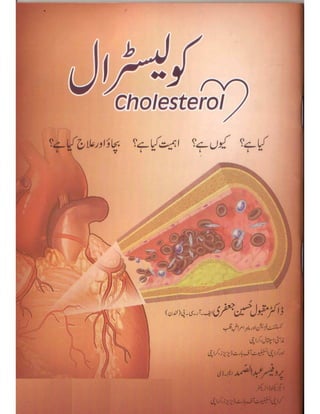
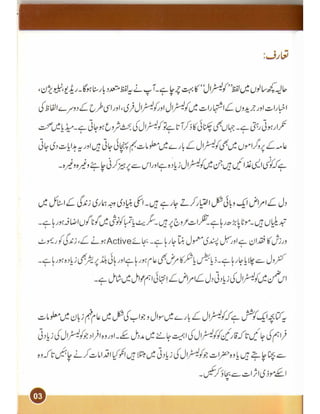
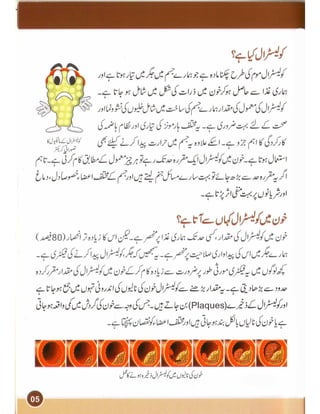
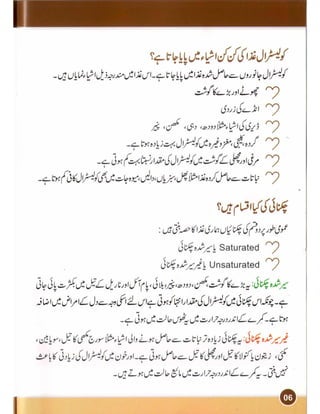

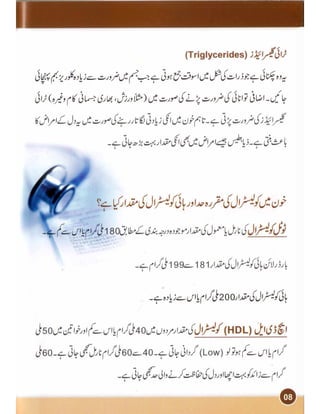
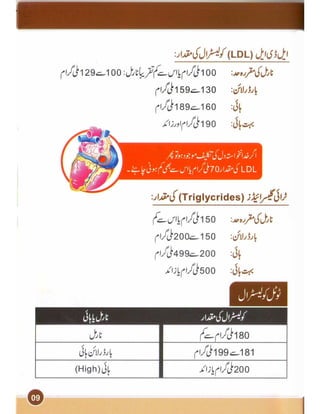
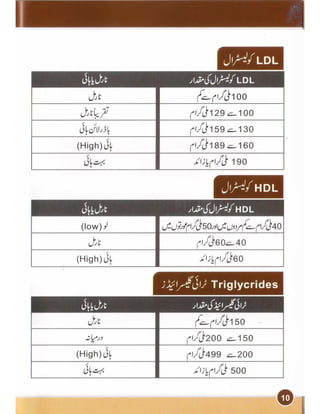
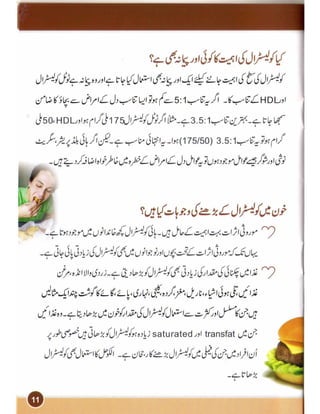
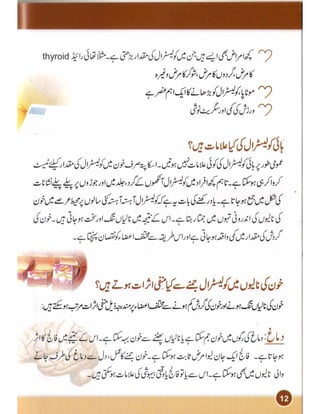
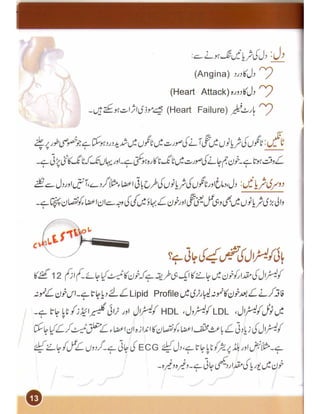
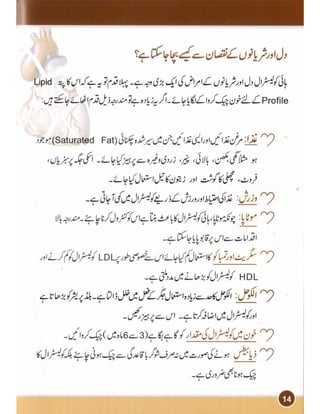
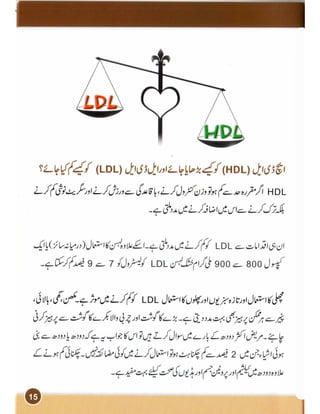

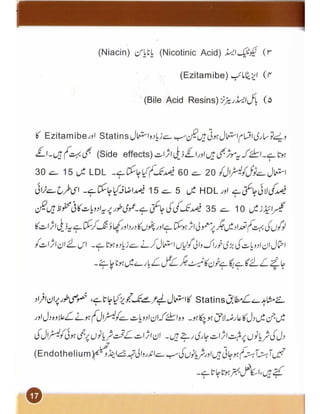
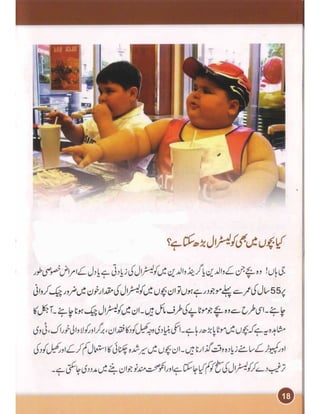
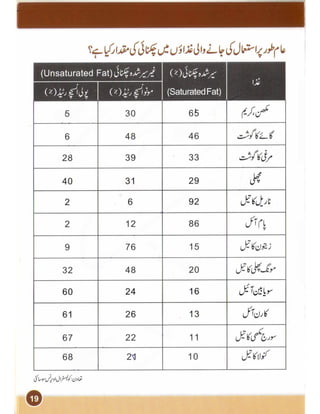
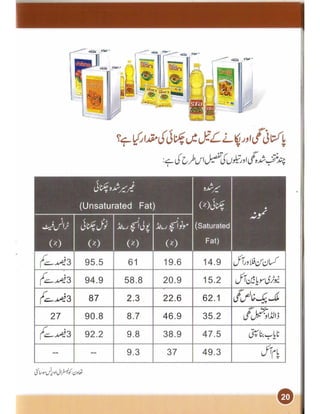
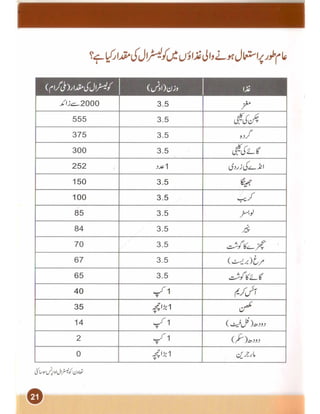
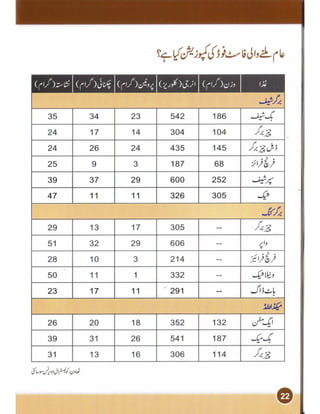

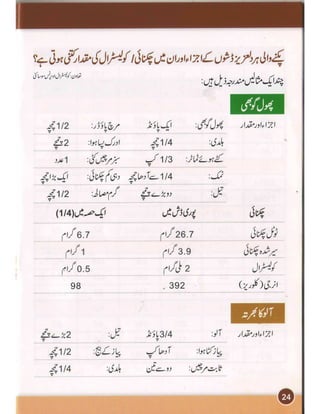
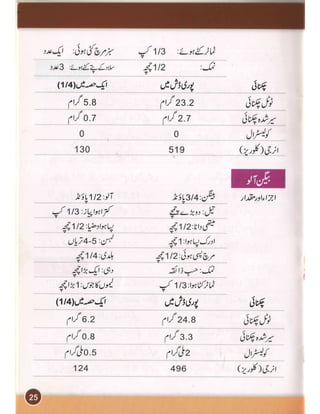
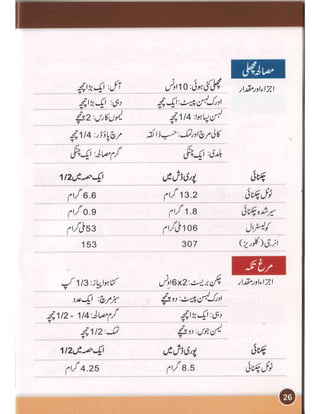
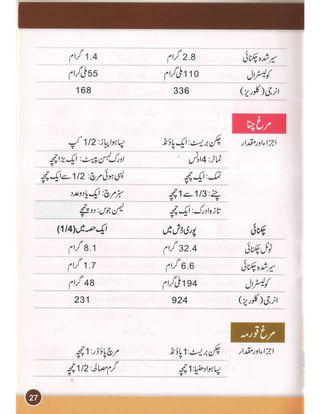
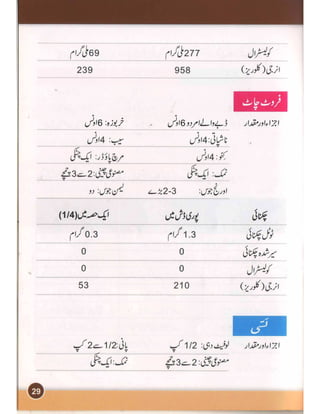
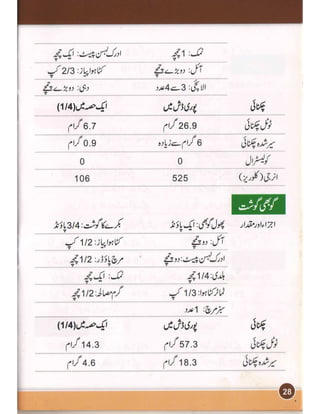
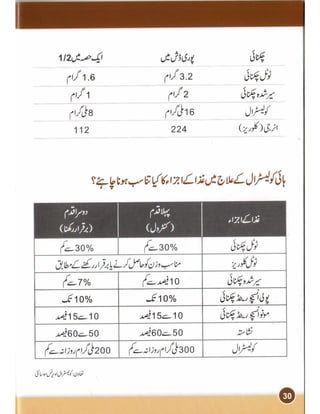
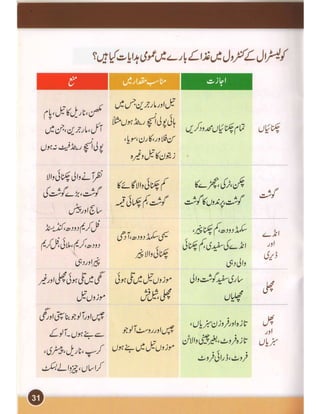
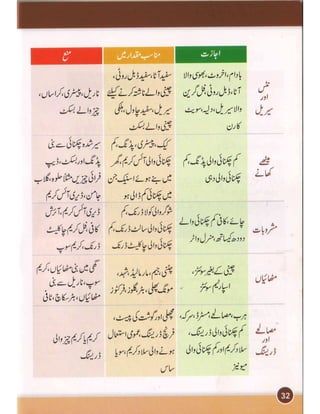

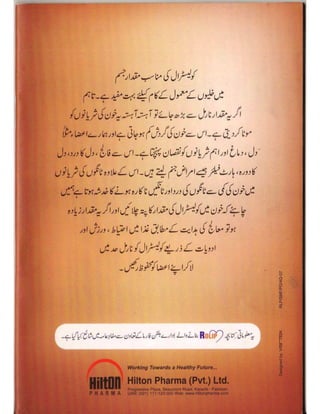
Ad
Recommended
pharmaceutical clean room
pharmaceutical clean room Kiran Thakur
?
This document provides an introduction to pharmaceutical clean rooms. It discusses the purpose of clean rooms which is to promote successful cleanroom operations and ensure safety. Clean rooms are classified according to international standards based on the number of permitted particles per cubic meter of air. Sources of contamination are discussed as well as methods for contamination control including personnel control, environmental control, and atmospheric monitoring. The conclusion states that the main purpose of a clean room is to prevent contamination of products and ensure quality according to good manufacturing practices.ISO 22000:2018 FSMS manual template (preview)
ISO 22000:2018 FSMS manual template (preview)Centauri Business Group Inc.
?
The document is a manual for ISO 22000:2017 food safety management systems, outlining the responsibilities, communication, and analysis of interested parties relevant to food safety within [company name]. It details roles and responsibilities of management and staff in ensuring compliance with food safety regulations, operational controls, and communication processes. The document also emphasizes the importance of a safe work environment and the ongoing training and competence of personnel involved in food safety management.Oracle Sourcing Setup
Oracle Sourcing SetupAjay Singh
?
Here are the default price break types that can be specified in Oracle Sourcing:
- Quantity
- Delivery Date
- Delivery Location
- Payment Terms
- Other (user defined)
The Sourcing administrator can select one or more of these as the default types that will be available for buyers to select when defining price breaks in their negotiations.
ALLOWING AWARD APPROVAL TO BE REQUIRED
You can configure Oracle Sourcing to require approval of negotiation awards before the resulting purchase orders
are generated. This allows your organization to implement approval workflows for sourcing awards.
To configure award approval:
Navigation Path
Sourcing Super User (R)? NegotIMS .ppt
IMS .pptssuserf260b6
?
This document discusses integrated management systems that combine quality management, environmental management, and occupational health and safety management. It provides an overview of ISO 9001 for quality management, ISO 14001 for environmental management, and benefits of an integrated management system (IMS) that includes common requirements, documentation structure, and benefits such as unified policies, procedures, audits and certification. The key benefit of an IMS is that it streamlines multiple separate management systems into a single integrated system.iSupplier
iSupplierravisagaram
?
The document provides an overview of the iSupplier portal, including its key features, architecture, registration process, and key supplier processes like PO acknowledgement, requests for changes, advance shipment notices, and invoices. The portal allows for real-time communication between suppliers and buyers by enabling suppliers to view POs, acknowledgements, shipments, and invoices and submit advance notices and invoices. It also describes the required setups for responsibilities, security, and profiles.Oracle Applications R12 Sourcing Training
Oracle Applications R12 Sourcing TrainingDharmalingam Kandampalayam Shanmugam
?
The document provides a comprehensive overview of Oracle Sourcing within the R12 applications, detailing various sourcing procedures, negotiation types, and data flow processes. It highlights the importance of integrated sourcing for optimizing supplier relationships, managing procurement costs, and facilitating negotiations through structured workflows. Additionally, it discusses limitations on purchasing order updates, technical requirements, and references for further information.Diabetes Mellitus
Diabetes MellitusMD Abdul Haleem
?
This document provides an overview of diabetes mellitus (DM), including the three main types (Type 1, Type 2, and gestational diabetes), signs and symptoms, complications, pathophysiology, oral manifestations, dental management considerations, emergency management, diagnosis, and treatment. DM is caused by either the pancreas not producing enough insulin or cells not responding properly to insulin, resulting in high blood sugar levels. The document compares and contrasts the characteristics of Type 1 and Type 2 DM.WD - Unit - 2 - HTML & CSS
WD - Unit - 2 - HTML & CSSGyanmanjari Institute Of Technology
?
The document discusses the benefits of exercise for both physical and mental health. It notes that regular exercise can reduce the risk of diseases like heart disease and diabetes, improve mood, and reduce feelings of stress and anxiety. The document recommends that adults get at least 150 minutes of moderate exercise per week or 75 minutes of vigorous exercise per week to experience these benefits.Python Programming ADP VTU CSE 18CS55 Module 2 Chapter 6
Python Programming ADP VTU CSE 18CS55 Module 2 Chapter 6Demian Antony DMello
?
Manipulating Strings with PythonZs 0952 zagor - u sakama robijasa (scanturion & folpi & emeri)(5 mb)
Zs 0952 zagor - u sakama robijasa (scanturion & folpi & emeri)(5 mb)zoran radovic
?
The document discusses the benefits of exercise for mental health. Regular physical activity can help reduce anxiety and depression and improve mood and cognitive functioning. Exercise has also been shown to increase gray matter volume in the brain and reduce risks for conditions like Alzheimer's and dementia.Quran with Tajwid Surah 83 ??????? ???? ????????? Al-Mutaffifeen ? PDF
Quran with Tajwid Surah 83 ??????? ???? ????????? Al-Mutaffifeen ? PDFCaller To Islam / ??????? ????????
?
LIST OF SURAHS ? https://plus.google.com/+CallertoislamTk-site/posts/eF8NukHeGDBZagor VC-037 Tajna talismana
Zagor VC-037 Tajna talismanaStripovizijacom
?
The document discusses the benefits of exercise for both physical and mental health. It notes that regular exercise can reduce the risk of diseases like heart disease and diabetes, improve mood, and reduce stress and anxiety levels. Exercise is also said to boost brain health and function as we age by increasing blood flow and oxygen to the brain.ZS - 0344 - Teks Viler - ATENTAT U LAS VEGASU
ZS - 0344 - Teks Viler - ATENTAT U LAS VEGASUStripovizijacom
?
ZS - 0344 - Teks Viler - ATENTAT U LAS VEGASUTex Willer Strip Agent Gigant 007 - Velika plja?ka
Tex Willer Strip Agent Gigant 007 - Velika plja?kaStripovizijacom
?
The document discusses the importance of climate change awareness and the need for immediate action. It highlights various environmental impacts and the role individuals can play in mitigating these issues. The text calls for collective efforts to promote sustainable practices and policies.OSV - Unit - 6 - Memory Management
OSV - Unit - 6 - Memory ManagementGyanmanjari Institute Of Technology
?
Memory Management requirements, Memory partitioning: Fixed and Variable Partitioning, Memory Allocation: Allocation Strategies (First Fit, Best Fit, and Worst Fit), Swapping, Paging and Fragmentation. Demand Paging, Security Issues.
Virtual Memory: Concepts, VM management, Page Replacement Policies (FIFO, LRU, Optimal, Other Strategies), Thrashing.Quran with Tajwid Surah 31 ??????? ???? ?????? Luqman ? PDF
Quran with Tajwid Surah 31 ??????? ???? ?????? Luqman ? PDFCaller To Islam / ??????? ????????
?
LIST OF SURAHS ? https://plus.google.com/+CallertoislamTk-site/posts/eF8NukHeGDBQuran with Tajwid Surah 100 ??????? ???? ????????? Al-'Adiyat ? PDF
Quran with Tajwid Surah 100 ??????? ???? ????????? Al-'Adiyat ? PDFCaller To Islam / ??????? ????????
?
LIST OF SURAHS ? https://plus.google.com/+CallertoislamTk-site/posts/eF8NukHeGDBQuran with Tajwid Surah 96 ??????? ???? ?????? Al-Alaq ? PDF
Quran with Tajwid Surah 96 ??????? ???? ?????? Al-Alaq ? PDFCaller To Islam / ??????? ????????
?
LIST OF SURAHS ? https://plus.google.com/+CallertoislamTk-site/posts/eF8NukHeGDBINGLES SIN BARRERAS MANUAL 10Sara Garrido
?
Subi estos Manuales del Curso de Ingl®¶s Sin Barreras
Cualquier cooperaci®Æn que desee hacer, se los agradecer®¶.
Banco Estado 23962390676
mi mail es el s_alicia2008@hotmail.com
More Related Content
What's hot (20)
WD - Unit - 2 - HTML & CSS
WD - Unit - 2 - HTML & CSSGyanmanjari Institute Of Technology
?
The document discusses the benefits of exercise for both physical and mental health. It notes that regular exercise can reduce the risk of diseases like heart disease and diabetes, improve mood, and reduce feelings of stress and anxiety. The document recommends that adults get at least 150 minutes of moderate exercise per week or 75 minutes of vigorous exercise per week to experience these benefits.Python Programming ADP VTU CSE 18CS55 Module 2 Chapter 6
Python Programming ADP VTU CSE 18CS55 Module 2 Chapter 6Demian Antony DMello
?
Manipulating Strings with PythonZs 0952 zagor - u sakama robijasa (scanturion & folpi & emeri)(5 mb)
Zs 0952 zagor - u sakama robijasa (scanturion & folpi & emeri)(5 mb)zoran radovic
?
The document discusses the benefits of exercise for mental health. Regular physical activity can help reduce anxiety and depression and improve mood and cognitive functioning. Exercise has also been shown to increase gray matter volume in the brain and reduce risks for conditions like Alzheimer's and dementia.Quran with Tajwid Surah 83 ??????? ???? ????????? Al-Mutaffifeen ? PDF
Quran with Tajwid Surah 83 ??????? ???? ????????? Al-Mutaffifeen ? PDFCaller To Islam / ??????? ????????
?
LIST OF SURAHS ? https://plus.google.com/+CallertoislamTk-site/posts/eF8NukHeGDBZagor VC-037 Tajna talismana
Zagor VC-037 Tajna talismanaStripovizijacom
?
The document discusses the benefits of exercise for both physical and mental health. It notes that regular exercise can reduce the risk of diseases like heart disease and diabetes, improve mood, and reduce stress and anxiety levels. Exercise is also said to boost brain health and function as we age by increasing blood flow and oxygen to the brain.ZS - 0344 - Teks Viler - ATENTAT U LAS VEGASU
ZS - 0344 - Teks Viler - ATENTAT U LAS VEGASUStripovizijacom
?
ZS - 0344 - Teks Viler - ATENTAT U LAS VEGASUTex Willer Strip Agent Gigant 007 - Velika plja?ka
Tex Willer Strip Agent Gigant 007 - Velika plja?kaStripovizijacom
?
The document discusses the importance of climate change awareness and the need for immediate action. It highlights various environmental impacts and the role individuals can play in mitigating these issues. The text calls for collective efforts to promote sustainable practices and policies.OSV - Unit - 6 - Memory Management
OSV - Unit - 6 - Memory ManagementGyanmanjari Institute Of Technology
?
Memory Management requirements, Memory partitioning: Fixed and Variable Partitioning, Memory Allocation: Allocation Strategies (First Fit, Best Fit, and Worst Fit), Swapping, Paging and Fragmentation. Demand Paging, Security Issues.
Virtual Memory: Concepts, VM management, Page Replacement Policies (FIFO, LRU, Optimal, Other Strategies), Thrashing.Quran with Tajwid Surah 31 ??????? ???? ?????? Luqman ? PDF
Quran with Tajwid Surah 31 ??????? ???? ?????? Luqman ? PDFCaller To Islam / ??????? ????????
?
LIST OF SURAHS ? https://plus.google.com/+CallertoislamTk-site/posts/eF8NukHeGDBQuran with Tajwid Surah 100 ??????? ???? ????????? Al-'Adiyat ? PDF
Quran with Tajwid Surah 100 ??????? ???? ????????? Al-'Adiyat ? PDFCaller To Islam / ??????? ????????
?
LIST OF SURAHS ? https://plus.google.com/+CallertoislamTk-site/posts/eF8NukHeGDBQuran with Tajwid Surah 96 ??????? ???? ?????? Al-Alaq ? PDF
Quran with Tajwid Surah 96 ??????? ???? ?????? Al-Alaq ? PDFCaller To Islam / ??????? ????????
?
LIST OF SURAHS ? https://plus.google.com/+CallertoislamTk-site/posts/eF8NukHeGDBINGLES SIN BARRERAS MANUAL 10Sara Garrido
?
Subi estos Manuales del Curso de Ingl®¶s Sin Barreras
Cualquier cooperaci®Æn que desee hacer, se los agradecer®¶.
Banco Estado 23962390676
mi mail es el s_alicia2008@hotmail.com
Quran with Tajwid Surah 83 ??????? ???? ????????? Al-Mutaffifeen ? PDF
Quran with Tajwid Surah 83 ??????? ???? ????????? Al-Mutaffifeen ? PDFCaller To Islam / ??????? ????????
?
Quran with Tajwid Surah 100 ??????? ???? ????????? Al-'Adiyat ? PDF
Quran with Tajwid Surah 100 ??????? ???? ????????? Al-'Adiyat ? PDFCaller To Islam / ??????? ????????
?
More from Riaz Masud (20)
Arabic potery
Arabic poteryRiaz Masud
?
The document discusses the benefits of exercise for mental health. It notes that regular physical activity can help reduce anxiety and depression and improve mood and cognitive function. Exercise causes chemical changes in the brain that may help alleviate symptoms of mental illness.Verses power urdu
Verses power urduRiaz Masud
?
The document discusses the benefits of exercise for mental health. Regular physical activity can help reduce anxiety and depression and improve mood and cognitive functioning. Exercise causes chemical changes in the brain that may help protect against mental illness and improve symptoms.Ornamental plant urdu
Ornamental plant urduRiaz Masud
?
The document discusses the benefits of exercise for mental health. Regular physical activity can help reduce anxiety and depression and improve mood and cognitive functioning. Exercise has also been shown to increase gray matter volume in the brain and reduce risks for conditions like Alzheimer's and dementia.Ad
Recently uploaded (20)
Trending-Now_-Ayurvedic-Bone-Regeneration-Therapies-for-AVN-_2025_.ppt
Trending-Now_-Ayurvedic-Bone-Regeneration-Therapies-for-AVN-_2025_.pptkhephioisols
?
Discover how Ayurvedic therapies in 2025 offer non-invasive, holistic solutions for avascular necrosis (AVN), promoting bone regeneration and improved mobilityCommon Medical Billing Errors.pppptttttx
Common Medical Billing Errors.pppptttttxjohnbutlermbc
?
Explaining how Common Medical Billing Errors could be costing you revenue loss, and how Medical Billers and Coders can help you to reduce it.
Errors that Could be Deemed Fraudulent in Ambulance Billing.pptx
Errors that Could be Deemed Fraudulent in Ambulance Billing.pptxjohnbutlermbc
?
Ambulance Billing could be replete with errors that could end up in being a fraudulent case. Know how to ensure correct billing.
Improving access to appropriately fitted equipment to support mothers express...
Improving access to appropriately fitted equipment to support mothers express...Health Innovation Wessex
?
The document outlines a project toolkit created by Health Innovation Wessex to improve access to properly fitted equipment for mothers expressing breast milk, aimed at promoting better health outcomes for premature infants. It includes two sections: the first discussing the project's background and evidence, while the second provides resources and training materials for implementation in healthcare settings. The initiative is based on research indicating that correctly sized flanges can enhance milk yield and reduce discomfort, ultimately supporting maternal and infant health.
The original toolkit was published in January 2025. Version 2, published June 2025, contains further information about flange sizing and kits available. Ayurveda: Ancient Wisdom for Modern Wellness
Ayurveda: Ancient Wisdom for Modern WellnessNutrazin
?
Discover how the 5,000-year-old science of Ayurveda offers practical, daily habits for maintaining holistic health in today°Øs fast-paced world. This presentation explores the foundational principles of Ayurveda, including the three doshas, daily wellness routines (Dinacharya), seasonal practices (Ritucharya), and powerful natural remedies like herbal teas, adaptogens, and mindful breathing.
Whether you're a beginner or wellness enthusiast, learn how integrating simple Ayurvedic practices can enhance immunity, mental clarity, digestion, and emotional balance °™ all without dependency on synthetic medications.PPT Anticancer agent for B Pharm Fifth Semester students
PPT Anticancer agent for B Pharm Fifth Semester studentsDinesh Kawade
?
Anti-neoplastic agents:
Alkylating agents: Meclorethamine*, Cyclophosphamide, Melphalan,Chlorambucil, Busulfan, Thiotepa
Antimetabolites: Mercaptopurine*, Thioguanine, Fluorouracil, Floxuridine, Cytarabine, Methotrexate*, Azathioprine
Antibiotics: Dactinomycin, Daunorubicin, Doxorubicin, Bleomycin
Plant products: Etoposide, Vinblastin sulphate, Vincristin sulphate
Miscellaneous: Cisplatin, Mitotane.
Soft Tissue Injury/Handling in orthopedics.
Soft Tissue Injury/Handling in orthopedics.Dr. Prabhat Pandey
?
This presentation provides a comprehensive overview of soft tissue injuries commonly encountered in orthopedic practice. It covers the classification, pathophysiology, clinical features, diagnostic approaches, and evidence-based management strategies for various soft tissue injuries, including compartment syndrome, fracture blisters, open fracture, Morel-Lavall®¶e lesion etc .The content is designed to support medical students, orthopedic trainees, physiotherapists, and healthcare professionals in understanding the mechanisms of injury, treatment principles such as RICE and the importance of prevention in clinical practice.
In orthopedic trauma care, soft tissue management is as vital as the management of the skeletal injury itself. Often overshadowed by the dramatic presentation of fractures, soft tissue injuries profoundly influence prognosis, healing capacity, and surgical decision-making. As eloquently expressed by Gathorne Girdlestone:
°∞Fracture is an injury to soft tissues in which you shall also find a broken bone.°±
The vascular and biological integrity of the soft tissue envelope determines whether the fracture site heals naturally, requires surgical intervention, or develops complications like infection, non-union, or necrosis. This presentation explores not only the pathophysiology and classifications of soft tissue injuries but also offers a practical assessment and management framework for clinicians.
A fracture is not just a bony event°™it almost always represents underlying soft tissue trauma. The "zone of injury" around any fracture must be respected. This area often contains:
Muscle necrosis
Damaged microvasculature
Hidden contamination
Partial tendon tears or ligamentous damage
Neglecting this can lead to:
Infection
Nonunion
Soft tissue contracture
Compartment syndrome
Understanding this biomechanical interplay is crucial for interpreting injury severity, estimating healing potential, and customizing treatment plans. High-energy trauma such as RTAs or gunshot wounds causes widespread damage beyond what is visible, including deep muscular necrosis and occult vascular compromise.
The bone cannot heal in isolation. As the presentation emphasizes, soft tissue is the biological foundation upon which successful orthopedic outcomes rest. Whether in a rural trauma setting or a tertiary care surgical suite, meticulous attention to soft tissue injury:
Improves healing timelines
Reduces complication rates
Enhances functional outcomes
Saves limbs°™and sometimes lives
Soft tissue status is often the limiting factor in fracture healing.
Proper classification guides decision-making and prognosis.
Compartment syndrome is a limb-threatening emergency; recognize early!
Open fractures require urgent debridement and stabilization.
Use objective tools (e.g., MESS, GHOIS) for complex limb injuries.
Never underestimate edema or fracture blisters°™they signal deeper damage.
°∞Soft tissue management is not ancillary; it is fundamental.°±MCH (MATERNAL AND CHILD HEALTH) HEALTH Programmes
MCH (MATERNAL AND CHILD HEALTH) HEALTH ProgrammesDr. Mamta Gehlawat
?
A glimpse of some important existing MCH related programmes and schemes for 3rd year MBBS studentsAcetabular Labral Tears: Anatomy, Diagnosis, and Management
Acetabular Labral Tears: Anatomy, Diagnosis, and ManagementDr. Prabhat Pandey
?
This detailed presentation by Dr. Prabhat Pandey (DNB Resident, Tata Main Hospital, Jamshedpur) provides a comprehensive overview of acetabular labral tears, covering their anatomical, biomechanical, and clinical implications. Beginning with the anatomy of the acetabular labrum°™a fibrocartilaginous structure critical for hip joint stability°™the presentation explains how its vascular and neural distribution contributes to both pain and poor healing potential when torn.
The pathophysiology of labral tears is discussed in the context of altered joint mechanics, loss of the labral seal, increased cartilage stress, and subsequent joint degeneration. The presentation classifies labral tears based on location, morphology, and etiology, highlighting causes such as trauma, femoroacetabular impingement (FAI), developmental dysplasia of the hip (DDH), and biomechanical imbalances.
Key clinical features are outlined, including chronic anterior hip or groin pain, mechanical symptoms like clicking and locking, and delayed diagnosis°™especially in athletes and women. Diagnostic strategies include physical tests (e.g., FABER, McCarthy test, anterior impingement test), imaging (X-ray, CT, MRI, and MR arthrography), and diagnostic injections.
Management strategies range from conservative treatment°™rest, anti-inflammatory drugs, and physiotherapy°™to surgical options, such as arthroscopic debridement and microfracture techniques. Postoperative rehabilitation focuses on early mobilization, DVT prophylaxis, and gradual return to function, tailored to reduce recurrence and promote joint preservation.
This presentation is an excellent educational resource for orthopedic residents, sports medicine practitioners, physiotherapists, and clinicians managing hip pathologies.Weight loss podcast motivation for 2025.
Weight loss podcast motivation for 2025.lalaaligujjar
?
Weight loss tips.weight loss.weight loss for beginners Shamis Tate Shares 5 Essential Brain Health Tips.pdf
Shamis Tate Shares 5 Essential Brain Health Tips.pdfShamis Tate
?
Neurologist Shamis Tate shares 5 simple and effective brain health tips. Learn how good sleep, healthy food, staying active, using your mind, and connecting with others can help keep your brain strong, sharp, and healthy. Easy steps that anyone can follow to feel better and think clearer every day.Antihistaminic agents for B Pharm Fifth semester students
Antihistaminic agents for B Pharm Fifth semester studentsDinesh Kawade
?
Antihistaminic agents: Histamine, receptors and their distribution in the human body
H1®Cantagonists: Diphenhydramine hydrochloride*, Dimenhydrinate, Doxylamines cuccinate, Clemastine fumarate, Diphenylphyraline hydrochloride, Tripelenamine hydrochloride, Chlorcyclizine hydrochloride, Meclizine hydrochloride, Buclizine hydrochloride, Chlorpheniramine maleate, Triprolidine hydrochloride*, Phenidamine tartarate, Promethazine hydrochloride*, Trimeprazine tartrate, Cyproheptadine hydrochloride, Azatidine maleate,
Astemizole, Loratadine, Cetirizine, Levocetrazine Cromolyn sodium
H2-antagonists: Cimetidine*, Famotidine, Ranitidin.
Gastric Proton pump inhibitors: Omeprazole, Lansoprazole, Rabeprazole, Pantoprazole
Weaning Modes of Mechanical Ventilation: Principles and Practices
Weaning Modes of Mechanical Ventilation: Principles and PracticesDr. Prabhat Pandey
?
This educational presentation, created by Dr. Prabhat Pandey under the guidance of Dr. Aditya and moderated by Dr. Rakesh Nigam, offers a comprehensive overview of the weaning process from mechanical ventilation. The session begins with foundational definitions and discusses the clinical necessity of timely weaning, emphasizing the risks associated with prolonged ventilator support, such as ventilator-associated pneumonia, airway trauma, barotrauma, and increased healthcare costs.
The presentation outlines a structured approach to weaning, including readiness assessment and clinical weaning trials. Traditional methods like Spontaneous Breathing Trials (SBTs), Pressure Support Ventilation (PSV), and Synchronized Intermittent Mandatory Ventilation (SIMV) are discussed in depth. Advanced techniques such as automated weaning protocols and the use of non-invasive ventilation (NIV) post-extubation are also introduced as part of modern critical care practice.
Furthermore, the importance of peri-extubation care is highlighted, including assessment of airway patency, bulbar function, and secretion management. This resource is intended for medical students, interns, residents, and healthcare professionals seeking a thorough understanding of ventilator weaning protocols◊Ó–¬∞Ê√¿π˙º”¿˚∏£ƒ·—«÷›¡¢¥Û—ßÃÿ¬ÂøÀ∑÷–£±œ“µ÷§£®∞‰≥ß±´≥ß±œ“µ÷§ È£©‘≠∞Ê∂®÷∆
◊Ó–¬∞Ê√¿π˙º”¿˚∏£ƒ·—«÷›¡¢¥Û—ßÃÿ¬ÂøÀ∑÷–£±œ“µ÷§£®∞‰≥ß±´≥ß±œ“µ÷§ È£©‘≠∞Ê∂®÷∆taqyea
?
“ª±»“ªªπ‘≠º”¿˚∏£ƒ·—«÷›¡¢¥Û—ßÃÿ¬ÂøÀ∑÷–£±œ“µ÷§/CSU Stanislaus±œ“µ÷§ È2025‘≠∞Ê°æqfi±1954292140°øŒ“√«◊®“µ∞Ï¿Ì∞ƒ÷fi¥Û—ß±œ“µ÷§≥…º®µ•£¨√¿π˙¥Û—ß±œ“µ÷§≥…º®µ•,”¢π˙¥Û—ß±œ“µ÷§≥…º®µ•£¨º”ƒ√¥Û¥Û—ß±œ“µ÷§≥…º®µ•£¨–¬º”∆¬¥Û—ß±œ“µ÷§≥…º®µ•£¨–¬Œ˜¿º¥Û—ß±œ“µ÷§≥…º®µ•£¨∫´π˙¥Û—ß±œ“µ÷§≥…º®µ•£¨»’±æ¥Û—ß±œ“µ÷§≥…º®µ•°£
°æ∏¥øÓªÃ◊º”¿˚∏£ƒ·—«÷›¡¢¥Û—ßÃÿ¬ÂøÀ∑÷–£±œ“µ÷§≥…º®µ•–≈∑‚µ»≤ƒ¡œ◊Ó«ø𕬑,Buy California State University, Stanislaus Transcripts°ø
π∫¬Ú»’∫´≥…º®µ•°¢”¢π˙¥Û—ß≥…º®µ•°¢√¿π˙¥Û—ß≥…º®µ•°¢∞ƒ÷fi¥Û—ß≥…º®µ•°¢º”ƒ√¥Û¥Û—ß≥…º®µ•£®qŒ¢1954292140£©–¬º”∆¬¥Û—ß≥…º®µ•°¢–¬Œ˜¿º¥Û—ß≥…º®µ•°¢∞Æ∂˚¿º≥…º®µ•°¢Œ˜∞‡—¿≥…º®µ•°¢µ¬π˙≥…º®µ•°£≥…º®µ•µƒ“‚“Â÷˜“™ÃÂœ÷‘⁄÷§√˜—ßœ∞ƒ‹¡¶°¢∆¿π¿—ß ı±≥æ∞°¢’π æ◊€∫œÀÿ÷ °¢Ã·∏fl¬º»°¬ £¨“‘º∞ «◊˜Œ™¡Ù–≈»œ÷§…Í«Î≤ƒ¡œµƒ“ª≤ø∑÷°£
º”¿˚∏£ƒ·—«÷›¡¢¥Û—ßÃÿ¬ÂøÀ∑÷–£≥…º®µ•ƒ‹πªÃÂœ÷ƒ˙µƒµƒ—ßœ∞ƒ‹¡¶£¨∞¸¿®º”¿˚∏£ƒ·—«÷›¡¢¥Û—ßÃÿ¬ÂøÀ∑÷–£øŒ≥Ã≥…º®°¢◊®“µƒ‹¡¶°¢—–æøƒ‹¡¶°££®qŒ¢1954292140£©æflÿ¥Àµ£¨≥…º®±®∏ʵ•Õ®≥£∞¸∫¨—ß…˙µƒ—ßœ∞ººƒ‹”Îœ∞πfl°¢∏˜ø∆≥…º®“‘º∞¿œ ¶∆¿”Ôµ»≤ø∑÷£¨“Ú¥À£¨≥…º®µ•≤ªΩˆ «—ß…˙—ß ıƒ‹¡¶µƒ÷§√˜£¨“≤ «∆¿π¿—ß…˙ «∑Ò ∫œƒ≥∏ˆΩÔ˝œÓƒøµƒ÷ÿ“™“¿æ›£°
Œ“√«≥–≈µ≤…”√µƒ «—ß–£‘≠∞Ê÷Ω’≈£®‘≠∞Ê÷Ω÷ °¢µ◊…´°¢Œ∆¬∑£©Œ“√«π§≥ß”µ”–»´Ã◊Ω¯ø⁄‘≠◊∞…˱∏£¨Ãÿ ‚𧓒∂º «≤…”√≤ªÕ¨ª˙∆˜÷∆◊˜£¨∑¬’Ê∂»ª˘±æø…“‘¥ÔµΩ100%£¨À˘”–≥…∆∑“‘º∞𧓒–ßπ˚∂ºø…÷«∞∏¯øժߒπ 棨≤ª¬˙“‚ø…“‘∏˘æ›øժߓ™«ÛΩ¯––µ˜’˚£¨÷±µΩ¬˙“‚Œ™÷π£°
°æ÷˜”™œÓƒø°ø
“ª°¢π§◊˜Œ¥»∑∂®£¨ªÿπ˙–Ëœ»∏¯∏∏ƒ∏°¢«◊∆›≈Û”—ø¥œ¬Œƒ∆浃«Èøˆ£¨∞Ͽ̱œ“µ÷§|∞Ï¿ÌŒƒ∆æ: ¬Ú¥Û—ß±œ“µ÷§|¬Ú¥Û—ߌƒ∆æ°æqfi±1954292140°øº”¿˚∏£ƒ·—«÷›¡¢¥Û—ßÃÿ¬ÂøÀ∑÷–£—ߌª÷§√˜ È»Á∫Œ∞Ͽ̅ͫΣø
∂˛°¢ªÿπ˙Ω¯ÀΩ∆Û°¢Õ‚∆Û°¢◊‘º∫◊ˆ…˙“‚µƒ«Èøˆ£¨’‚–©µ•Œª «≤ª≤ȗرœ“µ÷§’ÊŒ±µƒ£¨∂¯«“π˙ƒ⁄√ª”–«˛µ¿»•≤È—Øπ˙Õ‚Œƒ∆浃’ʺŸ£¨“≤≤ª–Ë“™Ã·π©’Ê µΩÔ˝≤ø»œ÷§°£º¯”⁄¥À£¨∞Ï¿Ì√¿π˙≥…º®µ•º”¿˚∏£ƒ·—«÷›¡¢¥Û—ßÃÿ¬ÂøÀ∑÷–£±œ“µ÷§°æqfi±1954292140°øπ˙Õ‚¥Û—ß±œ“µ÷§, Œƒ∆æ∞Ï¿Ì, π˙Õ‚Œƒ∆æ∞Ï¿Ì, ¡Ù–≈Õ¯»œ÷§
»˝.≤ƒ¡œ◊…—Ø∞Ï¿Ì°¢»œ÷§◊…—Ø∞Ͽ̫κ”—ß¿˙πÀŒ °æŒ¢–≈:1954292140°øº”¿˚∏£ƒ·—«÷›¡¢¥Û—ßÃÿ¬ÂøÀ∑÷–£±œ“µ÷§π∫¬Ú÷∏¥Û—ߌƒ∆æπ∫¬Ú£¨±œ“µ÷§∞Ï¿Ì∫ÕŒƒ∆æ∞Ï¿Ì°£—ß‘∫Œƒ∆æ∂®÷∆£¨—ß–£‘≠∞ÊŒƒ∆æ≤π∞Ï£¨…®√˺˛Œƒ∆æ∂®◊ˆ£¨100%Œƒ∆æ∏¥øð£A Research Synopsis Presentation on Breast Cancer
A Research Synopsis Presentation on Breast CancerAvantika Gupta
?
ABSTRACT
°∞A Quasi experimental study to assess the effectiveness of structured teaching programe on knowledge regarding Breast Cancer among selected students of Rajkiya Kanya Mahavidyalaya College, Shimla, Himachal Pradesh.°±
Introduction: - Breast cancer is one of the most common Second types of cancer in India. In 2024, the estimated number of Breast cancer cases in Himachal Pradesh is 9,566. Breast Cancer is the second most common cancer among women in Himachal Pradesh also. The Indira Gandhi Medical College (IGMC) in Shimla reports an estimated 220 and 250 new Breast Cancer cases each year. The Theog region has the highest number of breast cancer cases across all age groups, especially for those aged 38 and older. The Rampur, Jubbal, and Kotkhai regions also have high incidences of breast cancer, particularly in the middle to older age groups.
Aim: - The aim of the study is to assess the knowledge regarding Breast Cancer among selected students of Rajkiya kanya Mahavidyalaya college, Shimla, Himachal Pradesh.
Methodology: - A Quantitative research approach with Quasi-experimental study (one group pre-test post-test design only) used for the study. The sample size will be 126 for final study and its 10% i.e.12 for pilot study. Purposive sampling technique will be used to select the sample. Pilot study will be done in Centre of Excellence Government College Sanjauli, Shimla-6, Himachal Pradesh and final study will be conducted in Rajkiya Kanya Mahavidyalaya College, Shimla, Himachal Pradesh. Data analysis will be planned with descriptive and inferential statistics.
Key Words: - Assess, Effectiveness, Structured Teaching Programme, Knowledge, Breast Cancer, Students, Rajkiya Kanya Mahavidyalaya College Shimla.
NEED
As per research early detection can save patient life. If this cannot be identified earlier, then this may cause serious illness or even death. Students must be necessary that they should have knowledge regarding Breast cancer. That°Øs why researcher want to conduct the study on college students to improve the knowledge related to Breast Cancer.
By going through all the review of literature related to knowledge regarding Breast cancer that the students having inadequate knowledge regarding Breast cancer. Further no study was found on knowledge regarding Breast cancer among college students in Shimla Himachal Pradesh.
So, the researcher wants to conduct research on it to enhance the knowledge of students to achieve an optimum level for patient°Øs quality of life.
CONCEPTUAL FRAMEWORK
Godfrey Hochbaum and Irwin Rosenstock (1950): - Hochbaum and Rosenstock are notable researchers who contributed to the development of the Health Belief Model (HBM).
The present study aims to assess the effectiveness of structured teaching programme on knowledge regarding Breast Cancer among students, of RKMV College, Shimla, Himachal Pradesh.
The proposed sample size will be 126 college students.
G Power Formula will be used in the study..................Public-Private Partnerships in Healthcare_ A Sustainable Model for African Na...
Public-Private Partnerships in Healthcare_ A Sustainable Model for African Na...oliverwanyama96
?
Across Africa, healthcare systems are under increasing pressure from rising populations, chronic underfunding, and infrastructure gaps that limit access to quality care. In response, Public-Private Partnerships (PPPs) are gaining momentum as a sustainable model to deliver healthcare infrastructure, services, and innovation.
Revision Total Hip Replacement (THR): Surgical Principles, Techniques, and Bo...
Revision Total Hip Replacement (THR): Surgical Principles, Techniques, and Bo...Dr. Prabhat Pandey
?
Revision Total Hip Replacement (THR) is among the most demanding procedures in orthopedic surgery. Unlike primary THR, it involves addressing pre-existing complications such as implant failure, dislocation, bone loss, or infection, often in the presence of compromised soft tissues and bone quality. While primary THR offers high success rates and reproducible outcomes, revision THR requires greater surgical expertise, meticulous planning, and personalized execution to restore function and minimize complications.
This presentation by Dr. Prabhat Pandey is designed as a comprehensive resource for orthopedic surgeons, residents, and joint reconstruction teams who seek to understand and master the essential principles, decision-making algorithms, and advanced techniques used in revision THR.
Revision hip arthroplasty is associated with:
Increased operative time and blood loss
Higher complication rates: infection, dislocation, thromboembolism, nerve injury, and periprosthetic fracture
The need to manage weakened bone stock and soft tissue envelope
Difficulty in removing failed implants, including intramedullary components.
Revision surgery is warranted in cases of:
Prosthetic dislocation or instability
Mechanical loosening of components
Implant wear or breakage
Periprosthetic fracture
Deep infection
Osteolysis or bone resorption
Painful loosening without overt signs of mechanical failure
Each case demands tailored intervention based on the severity and combination of these factors.
3. Principles of Successful Revision THR
Safe removal of loose or failed components
Preservation of host bone and soft tissue integrity
Effective reconstruction of bone defects using bone grafts or metal augments
Achieving stability of the revision components
Restoration of biomechanics, particularly the anatomical center of rotation.
Dislocation rates:
0.3®C10% in primary THR
Up to 28% in revision THR
Influencing Factors:
Surgical approach
Abductor muscle function
Component malpositioning
Patient compliance
Prosthesis longevity
Underlying diagnosis (e.g., hip fracture, neuromuscular disorder
Revision Total Hip Replacement is not merely a technical endeavor°™it is a test of surgical judgment, experience, and adaptability. Successful outcomes hinge on:
Thorough preoperative assessment
Judicious use of classification systems like Paprosky
Proficiency in implant removal
Skillful reconstruction of defects
Meticulous postoperative care
This presentation distills the complex decision-making process into an organized, practical guide for any surgeon facing the challenge of revision THR.
Understanding Surgical Approaches and Their Risks
Dislocation Types and Management
Preoperative Planning Essentials
Surgical Options for Instability and Revision
Operative Exposure and Implant Removal
Techniques for Removing Cemented Implants
Cementless Implant Removal
Managing Bone Deficiency in the Acetabulum
Paprosky Classification: Detailed Breakdown
Improving access to appropriately fitted equipment to support mothers express...
Improving access to appropriately fitted equipment to support mothers express...Health Innovation Wessex
?
Ad
